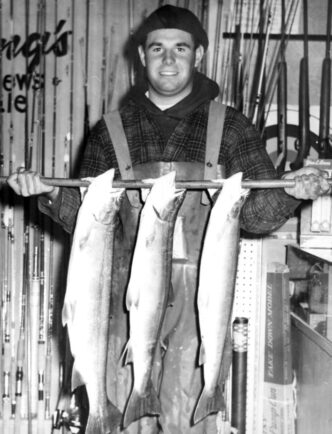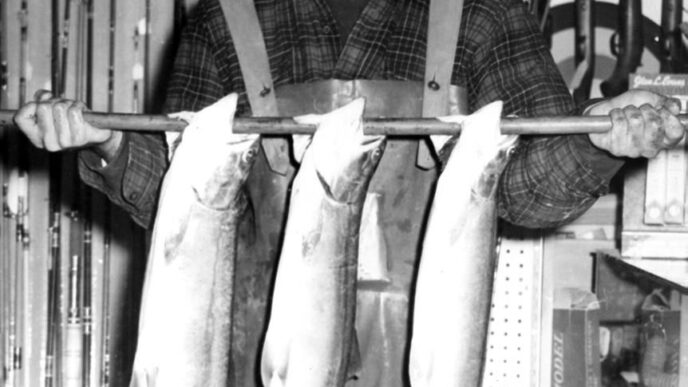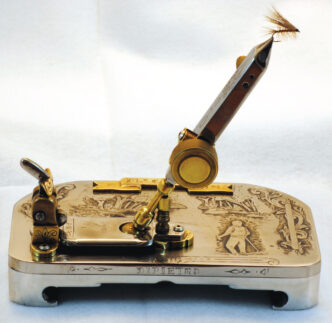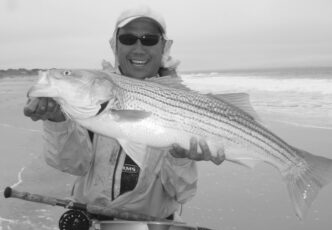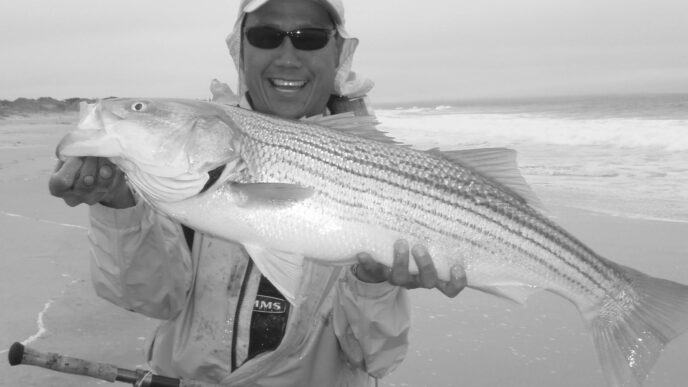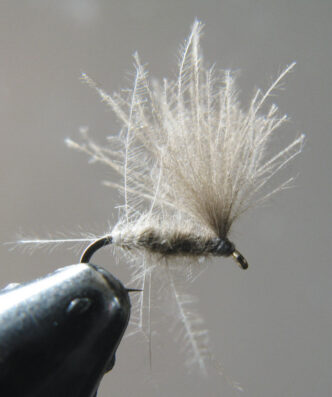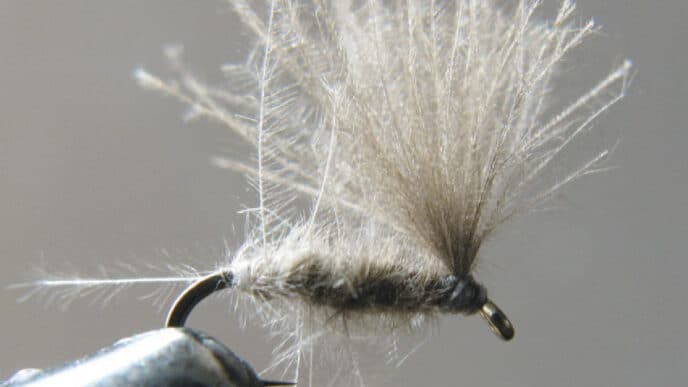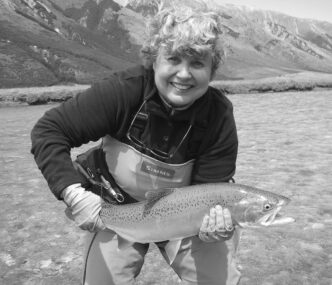People argue that the great boom in fly-fishing publishing — an era that began in the mid-1990s and ended 10 or a dozen years later — was doomed from the outset, inflated by unreasonable expectations and that the relative paucity of lyrical books coming out today is the natural order of things.
They ought to argue that. It’s true. Some of the evidence lines my walls, 24 shelves averaging 25 books each, accumulated since I started reviewing books for Fly Rod & Reel in 1997 — hundreds of new books, along with a few score earlier works, reissued during these years. And consider that these would hardly fill the foyer of a mansion preserving the era’s magazines — and I do hope something like that exists, somewhere — and, well . . . whew.
Quantity’s not quality. So how many of these tomes are terrific? Or good, even? You might be surprised. Maybe not awed, but sufficiently impressed, depending on your definitions. Few of the how-tos or where-tos failed to teach me something new. Some broke new ground that others covered again or mapped by new standards. Certainly, a tiny fraction of the words I consumed would have left a wiser man learned indeed.
Not just about fly fishing, either. More than a hundred books cram a case reserved strictly for “literature,” a sublibrary stack that long ago overflowed. That’s not because other books don’t rise to a lyrical level, but because that’s what these works aimed to be, with odds bits of how-to added when they tied into something else.
Now I’ll tell you a secret. Those how-tos and where-tos? I’ve read much of most of them. Some all the way. More, say four of five chapters. About a third I flipped through after 20 grinding minutes of pedestrian prose. The flipping was usually worthwhile, because of the photography from this era.
Those literary works? Successful, or merely aspiring? I pretty read them much cover-to-cover through all 10 feet. Never mind that I remember only eleven inches worth today. For days or weeks, I could have passed English 330 comprehension tests on these.
And here’s the rub: These are the books, the kinds of books, I see fewer of today and expect to miss more as time passes.
That’s partly because how-tos and where-tos still thrive — there are fewer, but most are better than ever. Many, not all, are written to higher standards, and the vast majority are illustrated beyond anything a 1980s author could hope for in terms of printing and color. True, each book costs as much as half an average angler’s library did, once upon a time, but there’s an appetite for these, a willing audience.
But “literature?” Not so much, and it’s not doing so well. In fact, the way publishing’s been going for five or six years — only God only knows where it will go from here — it might take three decades to fill a second bookcase this size, or whatever the miniscule digital publishing equivalent might be.
The top row of my literature bookcase begins alphabetically with Dave Ames, True Love and the Woolly Bugger (1996) — one of the most popular collections of the day. The last ends with Ed Zern — humor is literature, too — backed up to Ted Williams, my hero, W. D. Wetherell and — all all-stars, all through the alphabet. There’s Jim Babb, Bill Barich, Steve Bodio, Mallory Burton, Russ Chatham, Michael Checchio, on to James David Duncan, John Gierach, Dave Hughes, Ted Leeson, Nick Lyons, Joseph Heywood . . . and we’re not even halfway to Tom McGuane, an author many consider our best, or Harry Middleton. . . .
There are more rows — more names than I cam list here. And did I mention that history has its own shelves, including authors such as Darrel Martin, Steve Raymond, and Paul Schullery?
Boy, did we have it good, those of us to whom words matter. I don’t think we’ll have it better, as good, or anywhere close. Read or reread those writers’ books, if you doubt. Or don’t do either and think to yourself “Yeah well, that’s how old people feel about lots of things.” (It’s true, but you’re a hard one, you are.) And while it’s not as if these authors have passed on — though several have, sadly — it’s reasonable to wonder when you’ll hear from the living again.
Not as often, I’m afraid, if ever. That will sadden some of us, I promise. But I won’t pretend this decline is all bad. There may even be hope for both readers and writers alike. I’ll come round to that. But first, let me muse a little about boomtime.
Why so much talent, so many of whom appeared first or most often during this time? Did you wonder then? Or did you, like me, take this for granted . . . assuming it was always so, and will be? There are some obvious answers, inevitably offered with an Occam’s Razor sneer — the scimitar smile of every dull blade these days. Yes, yes there is money involved. But the best and most interesting answer starts and ends here: You.
You collectively, of course, as an audience and “market,” but also as the quality of reader who authors and publishers believed expected polished prose, meaning, wit — big words where they fit, laughter where it worked. As for writing down, as they say — as an all-angling editor once insisted I do. . . .
To you? No way. Better not. Seems like a bad idea.
Were there other elements at play? Sure. Let me dispose of these, without dismissing any.
A lot of writers fly fish, by comparison with other sports, partly because people can fly fish for life — a phenomenon not often the case for hockey or basketball, football or boxing, although George Foreman tried. Writers usually succeed, if at all, at or after the age when successful athletes give up seriously competing in a sport and start “as told to” memoirs. More importantly, it’s a solitary, thinking person’s game. Good fly fishing requires keen observation, rewards imagination, craft — several crafts — and the kind of commitment that can carry a lively mind through periods of frustration and failure, recriminations, wretchedness, and abject despair — just like writing.
Another reason: Until relatively recently, a surprising number of fly-fishing publishers maintained a determination to put out books consistent with our literary tradition, even if these were unlikely to turn significant profits — or none, as when Jim Pruett reissued Harry Middleton’s classics in paperback to keep them alive and support the education of Middleton’s kids. The Lyons Press, under Nick Lyons, printed scores of these, and while it was owned by him, kept them in print; Judith Schnell, of Stackpole Press, shepherded classics for years; and Frank Amato of Frank Amato Publications always made sure to include literary collections among abundant practical works. The late Gary LaFontaine at Greycliff championed Scott Sadil’s second book, Cast from the Edge…. And I could go on. . . .
I’m not suggesting that these individuals and outfits lost money on these books or expected to. What I will assert is that many took pride from contributing to flyfishing literary history and that this determination weighed heavily in how they determined a bottom line.
Was there greed involved? Sure. In one case, that’s all there was. Other companies, including some big ones, confined themselves to the “sure-profit” projects identified by their marketing departments. But these are . . . well, what they are.
In the main, way more often than not, the publishers and editors I’ve met were people that writers of a fly-fishing ilk wanted to fish with or, as happened more often, sit next to at table as conversations got lubricated and occasionally loud — dinners where by dessert, laughter was a constant, liquids were spilled, and the deepest draughts drew forth from the drinkers ever higher praise.
Or that’s how I remember those I’ve attended, hosted by publishing houses or magazines. I can’t recall a dull time, and only one where camaraderie didn’t reign. As to the clichés about authors’ colossal egos colliding with autocratic editors in leather vests and chaps — hey. If it makes for good stories. I was there. See this scar?
In other words, these were people that many readers might have enjoyed. At least I like to think so.
Which brings me, of course, back to you. Publishers trusted that you’d like — and buy — good books in numbers ranging from a very few thousand to five or six times that. Some sold many more, but the few blockbusters that broke into the mainstream were almost all promoted by major marketing efforts by major corporations. More’s the pity, to my mind, since the products promoted rarely ranked among the best.
Over the long run, it was a cadre of hard-core collectors and literate “sportsmen” and women who mattered. These and enough enamored newcomers eager to absorb the inked wisdom of others as engaged as they were, or hoped to be.
If book publishers had the history and future of our literature in mind, magazine editors had a related interest — Gray’s Sporting Journal for one, which has remained committed to standards few magazines in the world could meet. Fly Fisherman ran Nick Lyons on its back page, and that’s as good as it gets anywhere. The Fly Fisher, Fly Fishing, Trout, and the Amato mags all ran excellent essays often — but not always — with a conservation theme. Tom Bie’s Drake set out specifically, it seems to me, to capture the edgy, in-your-face material from young and old Turks.
That receptivity was certainly how I found things, submitting to Fly Rod & Reel’s “fiction issue,” a yearly competition for the Robert Traver Award offered by the John D. Voelker Foundation. Reserved for “Old boys?” Not hardly. I’ve helped judge that contest for five or six years, and every manuscript is anonymous, ultimately subject to a conference-call discussion that’s civil, however passionate.
I learned something more about that magazine after placing my first Traver also-ran. Emboldened by that — really, just comfortable with the people I’d met in the process — I approached then editor Jim Butler with a query for a travel piece on Bora Bora. The problem was, I couldn’t find anybody who knew much about fly fishing that island or most of the others in French Polynesia.
Butler laughed. “I don’t care if you catch a fish. Write a good story. For us, the writing is what it’s about.” (And still is, I think current editor Joe Healy would like me to add.)
Then of course there’s this magazine, which the editor would like me to softpedal, since I’ve ridden it a few times already.
Fine. Except for this. . . .
Writers are not born. To write as well as you, the reader, requires, takes most of us many years of practice. And that’s one area where the players of this current era mostly let you down.
I’ve said it many times in this series: From these editors, any new voice was welcome, presuming it was already polished, or so close that it needed nominal edits. There’s no farm league, and few had the editorial time required to develop talent — to provide concrete, detailed criticism — not once, but several times. Offering enough encouragement while saying “no” — and the money to make a “yes” seriously worthwhile? This magazine often has managed the former. The latter . . . can’t be done.
Let me clarify that: When it came to money, the industry — books and magazines — didn’t culture new writers because it couldn’t, can’t, and won’t in the foreseeable future. It’s just not that flush.
Digress here for a quick iteration of the relevant economics. During the best of times, the average advance publishers gave new writers was about $2,000 for a book. And since most books didn’t sell past advances, that was it. As for features, short stories, and essays in magazines . . . $300 to $500 was standard, with occasional pieces (usually illustrated) pulling half again that, occasionally double.
That was during the best of times — 10 years ago. We’re not talking 1902. So how did a new crop of lyrical writers make it?
They didn’t. Some tried. Greg Thomas spent a season sleeping in the crawl space beneath a friend’s house and might have stayed longer if Moose the Lab had not objected. (Or so I suspect.) Some would be’s guided, or worked in fly shops, trying to write in the off seasons or off hours, but sans a steady flow of rewards — at least of acknowledgment — and in the end, absent any promise of ever supporting a family or a Lab of Moose’s size. . . .
A few of readers may remember how this series started, with a comic book treatise on the nature of fly-fishing writing by and for the English elite, the only folks who had access to prime water — and books. Schullery summed this up in Part III: “Traditionally, at least up until the twentieth century, British fly-fishing history was dominated by brilliant amateurs. Now American fishing writing is more strongly dominated by professionals.”
Most of the writers whose work I’ll miss have day jobs — always have had — and still tap away, because they can’t stop. Commitment, compulsion — is there a difference?
So why will we see them less often?
Three reasons among half a dozen —
First, demographics. We age. Fewer people now take up fly fishing.
Second, the economy crashed. Of course — thank you, Occam. Not as many folks can drop five full “fins” on a collection of essays or short stories. Just as the high tide floated all, so do we fall. We’re all used to how that works. But in fly-fishing writing, that’s not the half of it.
Literally. Third, even during boomtime, writers’ revenues from books declined, even as retail prices rose dramatically. It’s not that boilerplate contracts for royalties changed, it’s that the world changed enough that the same pica-type clauses left authors gasping.
Historically, an author received a 5 to 15 percent royalty on the retail sales price. Let’s say you’re offered 10 percent. Read that and you might not notice the next clauses: This 10 percent holds true only on books the publisher sells at wholesale prices — generally around 60 percent of retail and always over 50 percent. But if a book sells below 50 — which in the old days happened only if it was remaindered or “cut out” — the author’s share falls to half his original royalty on the net that a publisher receives. In other words, if you had hoped to make an American dollar on a $10 book, and if the publisher pushed it out at 45 percent of retail, you got 5 percent of less than $5, which in best scenarios is what we call a “quarter.”
Come now discount stores. Come Amazon, or that greedy publisher who got caught “selling” thousands of fly-fishing books to himself. Suddenly, almost nothing between covers headed out at that higher royalty price.
Do the math. You, proud author, get $2,000 for an advance. Prices rise — huzzah — so your baby sells at an ungodly $20, enough to cramp the shopping hand of most people not related by blood. Even so, you sell out your run of 2000 books.
At 45 percent of list: 9 bucks.
Rat-a-tat-tat: You owe your publisher $1,100 of that advance. (Or more, subtracting damaged book returns.)
If that makes you cringe, wait until you see your spouse’s face.
And we wish you luck in this and all your other endeavors.
There now, that should do it — suggest, by itself, a discouraging enough word. And yet . . . that’s still not the whole story. That promise that what’s happened isn’t all bad? That assertion that as the answer starts with you, so shall it end?
For those who’ve been waiting to read the word “Internet” . . . here it comes.
It could have been 1997, Bill Kiene and I agree. I remember it was costing a buck or two an hour to “surf the Net,” as we cool dudes and dudettes all called it. I know I hadn’t found Dan Blanton’s supersite yet, or the many that would flash so briefly in the digital galaxy, so the fly-fishing bulletin board I visited (rec.outdoor.fishing.fly, Bill reminds me), was unmonitored and uncensored, with a marginal archive “under construction.”
Too bad, but after six heady months, the board seemed remarkable mainly for earnest, endlessly repeated questions from “newbies,” as in “Which rod should I buy, (high-end brand) or (high-end brand)?” Also for strident, apparently endless arguments on one or more of the following issues:
Killing fish (or not); Fishing indicators;
Killing people who fish indicators (or not, or how).
This got tiresome. So did the little cliques that formed, usually composed of people with a little knowledge and a lot of time on their hands. Screwballs provided strange entertainment — among these, a well-known tackle manufacturer, already banned elsewhere, whose political diatribes suggested third-term syphilis, and another provocateur, a “troller,” who would argue about anything that offered justification for his hysterical, homophobic rants.
The latter lasted until he tagged the wrong victim, another newbie, also a private investigator, who tracked him down, called his boss, and outed his identity to the world by posting his name above and below a lengthy collection of obscene tirades.
Interesting lesson, that. As in, this place ain’t so anonymous.
Some folks didn’t need it to be, I learned. Appearing amid the mundane and occasionally maniacal, calmly and modestly offering the benefit of experience was — Bill Kiene?
No kidding. How about that — offering expert answers gratis to anybody who asked. This was better than sliced bread in a serious sandwich.
I gave Mr. Kiene a call. What struck me was how much he enjoyed this outreach. But there was something else.
Turns out Bill always wanted to write. Like millions before him and after, however, he’d been bruised by English teachers — or a teaching system, if you prefer — whose lessons left him wary. But when it came to providing answers to issues he understood . . . what a kick.
For him, for me.
Many writers’ day jobs, in fly fishing and generally, involve teaching: writing, reading — “English.” It’s natural enough: The urge to write rises from reading; from reading, we learn. Add an urge to share treasure, and soon you’re standing in front of a black or white board sucking chalk dust or huffing marker fumes. This holds true for Leeson, Martin, Sadil — Nick Lyons taught, as did others, including me, for something over 20 years. And I can tell you this with confidence: For a writer who teaches, hearing that somebody’s found a way to enjoy themselves in words is a gift. It doesn’t matter if that somebody is your student, although that’s special, of course. If anybody’s writing for sheer pleasure, the world is a better place. Kumbaya.
I’ll let you decide why that would be so. For me, it’s as close as I’ll come to witnessing a welcome religious conversion. So “Halleluiah!” I thought after talking to Bill.
Ever after, I’ve sustained hope that “this Internet thing” would do for writing what movable type did for reading. It’s a faith that waxes and wanes, but I’m almost a true believer. I know Bill has published in print. . . .
So . . .
What does that suggest about the future of “literary writing?” Of stars like the ones we have?
First, the obligatory caveats.
Recall that in Part III of this series, I quoted Steve Raymond saying “Even the relatively few people who do have a natural talent for expressing themselves must have training and experience to write well” and that a college writing professor had asserted that “nobody could consider himself a writer until he had written at least 800,000 words. At the time I thought the professor was crazy; now I wonder why he set the figure so low.”
Now heed the words of Alexander King, a major minor writer from the 1950s, briefly famous for wearing a pink tie every day for 20 years, for his heroin habit, and for books including May This House be Safe from Tigers and an autobiography with the perfect title Mine Enemy Grows Older. King wearied of cocktail-party approaches by egoists — I think he mentioned stockbrokers — who often confronted him with, “I think I could have been a successful writer, if ” His riff went something like this: “Really? Are you a successful writer? No? Then relax, pal. You couldn’t have been one. Because half of what it takes is talent. The rest is commitment and it’s obvious you didn’t have that.”
Ow.
And caveat fin: lyrical books won’t disappear. Tony Lyons, Nick’s son, is carrying on with his Skyhorse Publishing; Jim Anker has brought out two books by Scott Sadil; and Ed Gray, once of Gray’s Sporting Journal, is starting over with his own collection. So. . . .
The point I wished to make by beginning this series I now hope is almost self-evident: Over and over I’ve talked about the quality of fly-fishing readers. I have done so for years. More importantly, to me, from the second or third of these 100-something “Meanders,” I’ve written to what I came to call “the sympathetic mind.” That means every piece is, to me, a conversation with you, the reader. I’m afraid it sounds presumptuous, but for 17 years, I’ve tried to imagine your part in these wanderings of mind and body with rod, what you would observe, think, say. You can be arch, even caustic. You’re more critical than I am, I fear but mostly, well, you’re sympathetic. You like to laugh.
I believe a lot of lyrical writers write that way and that this same sense of engagement is what many readers appreciate. You can see this clearly at any John Gierach reading, when fans line up for the signature of somebody they know, with whom they’ve shared.
Now 800,000 words is a bunch. The way we counted in the old days of doublespaced type, it ’s something over 3500 pages — better than a decade, if you write a page a day.
It doesn’t work exactly like that. But you take my drift. With thousands of literate, thinking readers participating in countless new forums, exchanging information, entertaining each other — sympathetic minds meeting in real time, also in formats that allow time for the careful composition of thought, with criticism offered in a variety of ways — encouragement, acknowledgement. . . .
What movable type did for reading….
Have I seen a new Ted Leeson? Not yet, but I’ve sure seen good stuff — and I don’t get around the Internet much. How about a Jim Babb, classics scholar from a Tennessee hill town, ex-navy swab, ex-lobsterman, now living in the Maine country beside a trout pond he built while writing and editing for Gray’s?
Not only that — and fodder for another day — fly-fishing Web sites such as Dan Blanton’s Bulletin Board, and Marshall Cutchin’s Midcurrent Fly Fishing have unleashed a whole new way to spread the word on every issue under an angler’s sun.
Magazines like this one will continue to thrive for all kinds of reasons, strong editing among them. But the conversation’s open; elitism is moot; merit conquers all, from amateur or pro.
So many, many sympathetic minds —
Boom, baby, boom.






